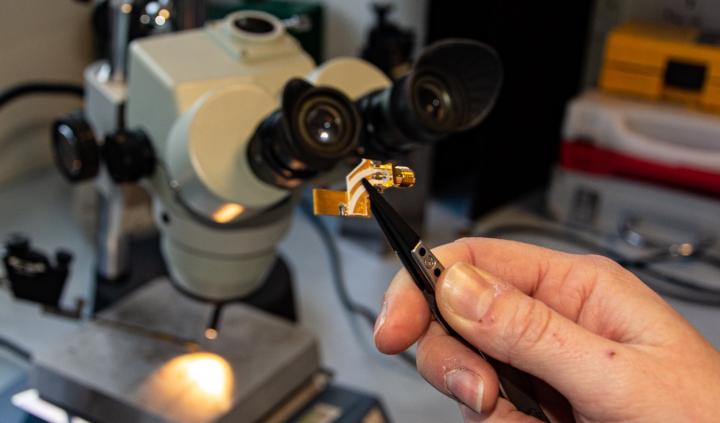
Credit: University of Leeds
Researchers have made a breakthrough in the control of terahertz quantum cascade lasers, which could lead to the transmission of data at the rate of 100 gigabits per second – around one thousand times quicker than a fast Ethernet operating at 100 megabits a second.
What distinguishes terahertz quantum cascade lasers from other lasers is the fact that they emit light in the terahertz range of the electromagnetic spectrum. They have applications in the field of spectroscopy where they are used in chemical analysis.
The lasers could also eventually provide ultra-fast, short-hop wireless links where large datasets have to be transferred across hospital campuses or between research facilities on universities – or in satellite communications.
To be able to send data at these increased speeds, the lasers need to be modulated very rapidly: switching on and off or pulsing around 100 billion times every second.
Engineers and scientists have so far failed to develop a way of achieving this.
A research team from the University of Leeds and University of Nottingham believe they have found a way of delivering ultra- fast modulation, by combining the power of acoustic and light waves. They have published their findings today (February 11th) in Nature Communications.
John Cunningham, Professor of Nanoelectronics at Leeds, said: “This is exciting research. At the moment, the system for modulating a quantum cascade laser is electrically driven – but that system has limitations.
“Ironically, the same electronics that delivers the modulation usually puts a brake on the speed of the modulation. The mechanism we are developing relies instead on acoustic waves.”
A quantum cascade laser is very efficient. As an electron passes through the optical component of the laser, it goes through a series of ‘quantum wells’ where the energy level of the electron drops and a photon or pulse of light energy is emitted.
One electron is capable of emitting multiple photons. It is this process that is controlled during the modulation.
Instead of using external electronics, the teams of researchers at Leeds and Nottingham Universities used acoustic waves to vibrate the quantum wells inside the quantum cascade laser.
The acoustic waves were generated by the impact of a pulse from another laser onto an aluminium film. This caused the film to expand and contract, sending a mechanical wave through the quantum cascade laser.
Tony Kent, Professor of Physics at Nottingham said “Essentially, what we did was use the acoustic wave to shake the intricate electronic states inside the quantum cascade laser. We could then see that its terahertz light output was being altered by the acoustic wave.”
Professor Cunningham added: “We did not reach a situation where we could stop and start the flow completely, but we were able to control the light output by a few percent, which is a great start.
“We believe that with further refinement, we will be able to develop a new mechanism for complete control of the photon emissions from the laser, and perhaps even integrate structures generating sound with the terahertz laser, so that no external sound source is needed.”
Professor Kent said: “This result opens a new area for physics and engineering to come together in the exploration of the interaction of terahertz sound and light waves, which could have real technological applications.”
###
Note to Editors
Image shows Dr Aniela Dunn, Research Fellow at the University of Leeds, holding the laser, on its mounting, in the palm of her hand.
For further information, please contact David Lewis in the press office at the University of Leeds on 0113 343 2049.
Once the embargo lifts, the paper will be available here: https:/
DOI: 10.1038/s41467-020-14662-w
University of Leeds
The University of Leeds is one of the largest higher education institutions in the UK, with more than 38,000 students from more than 150 different countries, and a member of the Russell Group of research-intensive universities. The University plays a significant role in the Turing, Rosalind Franklin and Royce Institutes.
We are a top ten university for research and impact power in the UK, according to the 2014 Research Excellence Framework, and are in the top 100 of the QS World University Rankings 2020. Additionally, the University was awarded a Gold rating by the Government’s Teaching Excellence Framework in 2017, recognising its ‘consistently outstanding’ teaching and learning provision. Twenty-six of our academics have been awarded National Teaching Fellowships – more than any other institution in England, Northern Ireland and Wales – reflecting the excellence of our teaching. Over a third of our academics are involved in applied research or as consultants to industry, and over the last ten years, the University of Leeds has produced more than 100 ‘spin-out’ companies.
http://www.
University of Nottingham
The University of Nottingham is a research-intensive university with a proud heritage, consistently ranked among the world’s top 100. Studying at the University of Nottingham is a life-changing experience and we pride ourselves on unlocking the potential of our 44,000 students – Nottingham was named both Sports and International University of the Year in the 2019 Times and Sunday Times Good University Guide, was awarded gold in the TEF 2017 and features in the top 20 of all three major UK rankings. We have a pioneering spirit, expressed in the vision of our founder Sir Jesse Boot, which has seen us lead the way in establishing campuses in China and Malaysia – part of a globally connected network of education, research and industrial engagement. We are ranked eighth for research power in the UK according to REF 2014. We have six beacons of research excellence helping to transform lives and change the world; we are also a major employer and industry partner – locally and globally.
Media Contact
David Lewis
[email protected]
44-011-334-32049
Related Journal Article
http://dx.




